Interface
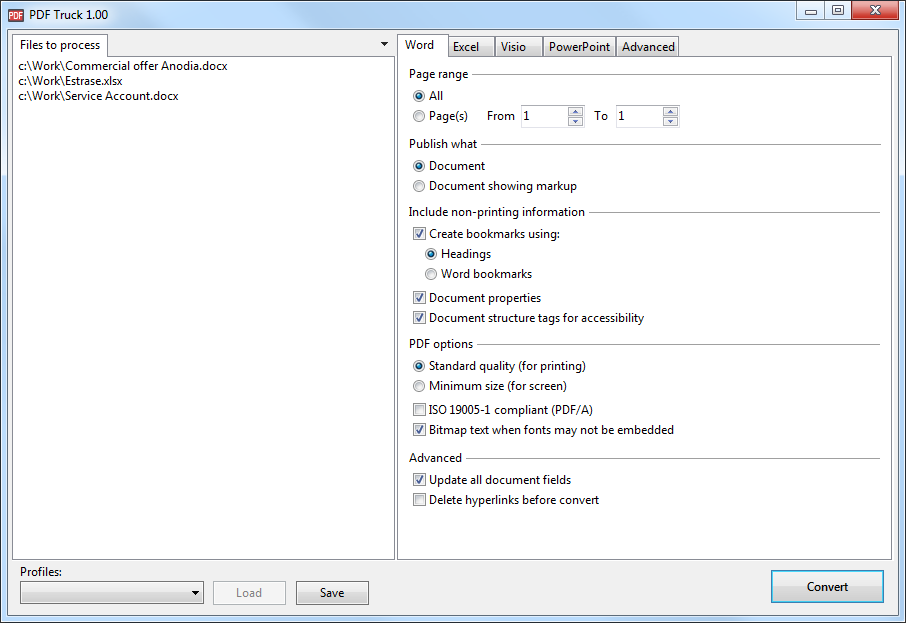
The program window is divided into several main areas:
- List of files for processing
- Tabs for setting conversion parameters
- Area for loading and saving conversion profiles
- Processing start button
Adding files
To add documents to the list for processing, you need to transfer the required
files from Explorer. While holding down the Ctrl key, new documents are added
to the list of existing ones. Otherwise, the list is cleared before new
documents are added.
In addition, you can add one of the currently open Microsoft Office documents using the menu under the arrow on the right above the list of files to be processed.

To remove individual files from the list, use the Del key.
The order of document processing can be changed by arrow keys Up and Down
with pressed Ctrl button.
Word settings
The tab for converting Word documents and the tabs for converting other formats are, for the most part, similar. There are, however, additional options here.
Page range

Here you can specify the range of pages to convert or choose to convert the entire document.
Publish what

Select the publication mode for corrections (reviews).
Include non-printing information
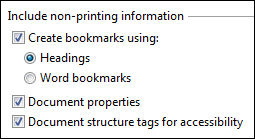
A PDF document can be bookmarked based on document titles or bookmarks.
When you select the Document properties option, the properties (title, subject,
author, and keywords) of the original Word document will be copied into the PDF document.
PDF options
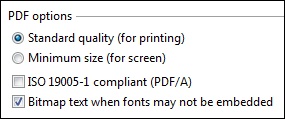
Optimization
This setting controls the options for converting bitmap images. If you select
Standard quality (for printing) the quality will be better, but the file size will be larger.
If you select Minimum size (for screen) the quality will be inferior, but the file
size will be smaller.
For some images, the difference between the two options is not noticeable.
In other cases, when choosing to Minimum size the image quality
deteriorates significantly. We, therefore, recommend that you always use the first option.
ISO 19005-1 compliant (PDF/A)
The PDF/A format (ISO 19005-1: 2005 standard) is a subset of the PDF standard. Documents in this format are intended for long-term (archival) storage. Image quality may deteriorate when this format is selected.
Bitmap text whet fonts may not be embedded
Some fonts cannot be embedded in a PDF document. When viewing a document on a system that does not support the font, the system uses one of the available fonts. Naturally, this font can be very different from the original one.
When this option is set, in cases where the font used cannot be embedded in the PDF document, texts using this font will be converted to a bitmap during conversion. Subsequently, when viewing this text, it will not be possible to copy it. The search function will not work. However, the style and appearance will be preserved.
Advanced

Update all document fields
Depending on the Word settings, the document fields may not be updated when printing. In this case, this option is useful. When it is selected, all fields of the document are updated before conversion.
These changes are not saved in the original document.
Delete hyperlinks before converting
This option allows you to remove hyperlinks from the document (links to Internet sites, email addresses, and external files) while links to places in the same document are preserved.
Note that many PDF viewers will automatically recognize URLs in the text and insert hyperlinks even when a document does not have a hyperlink option.
Excel settings
Similar to the settings page for Word documents, in Microsoft Excel, for the most part, PDF output options are the same. There are differences only in the Additional options.
Page range

Here you can specify the range of pages to convert or choose to convert the entire document.
Publish what

In this block, it is possible to select all sheets of the book for printing, or only the active one, and ignore the print area.
Include non-printing information

When this option is selected, the properties (title, subject, author, and keywords) of the original Excel document will be preserved during the conversion to PDF.
PDF options

Optimization
This setting controls the options for converting bitmap images. If you select
Standard quality (for printing), the quality will be better, but the file size will be larger.
If you select Minimum size (for screen), the quality will be inferior,
but the file size will be smaller.
For some images, the difference between the two options is not noticeable. In other cases,
when choosing to Minimum size, the image quality deteriorates
significantly. We, therefore, recommend that you always use the first option.
ISO 19005-1 compliant (PDF/A)
The PDF/A format (ISO 19005-1: 2005 standard) is a subset of the PDF standard. Documents in this format are intended for long-term (archival) storage. Image quality may deteriorate when this format is selected.
Advanced

Recalculate formulas if autocalc is disabled
In some Excel workbooks, the automatic calculation function may be disabled. In such instances, this setting is convenient. If it is selected before the conversion, the entire document will be automatically calculated.
Delete hyperlinks before converting
This option allows you to remove hyperlinks from the document (links to Internet sites, email addresses, and external files). In Excel, this option should be used with caution. When you delete a hyperlink, Excel changes the style of the cell, which can change the font, color, size, and style of the text.
Note that many PDF viewers will automatically recognize URLs in the text and insert hyperlinks even when a document does not have a hyperlink option.
Visio settings
Page range

Page range settings for conversion. You can select all pages, the active sheet, or a page range.
Color options

Color as black
Selecting this option converts the color to grayscale. Even colors that are not very dark will be shown as dark.
Include background
Enables or disables background printing.
Include non-printing information

Selecting the Document properties option will copy the properties (title,
subject, author, and keywords) of the original Visio document into the PDF.
PDF options

Optimization
This setting controls the options for converting bitmap images.
If you select Standard quality (for printing), the quality will be better,
but the file size will be larger. If you select Minimum size (for screen),
the quality will be inferior, but the file size will be smaller.
For some images, the difference between the two options is not noticeable.
In other cases, when choosing to Minimum size, the image
quality deteriorates significantly. We, therefore, recommend that you always use the first option.
ISO 19005-1 compliant (PDF/A)
The PDF/A (ISO 19005-1: 2005 standard) is a subset of the PDF standard. Documents in this format are intended for long-term (archival) storage. Image quality may deteriorate when this format is selected.
PowerPoint settings
Range

Page range settings for conversion. You can select all slides or a range of slides.
When specifying a range of pages to convert, hidden slides are also included in the
specified range, so if, for example, the range of pages 1–5 is selected and slide two is
hidden, but the option to Include hidden slides is inactive, the resulting
document will have only four pages.
Publish options

Publish what
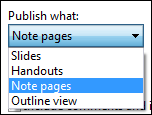
Slide display mode on pages: slides, handouts, note pages, and structure.
In the Slide display mode (printing of handouts), the slide placement settings become active: the number of slides per page and, if more than three slides per page are selected, their order.
There are also options to frame slides, enable the display of hidden slides, and display annotations.
Include non-printing information

When you select the Document properties option, the original PowerPoint document’s properties
(title, subject, author, and keywords) will be copied to the PDF.
PDF options
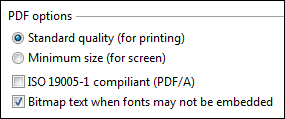
Optimization
This setting controls the options for converting bitmap images. If you select
Standard quality (for printing), the quality will be better, but the file size will be
larger. If you select Minimum size (for screen), the quality will be inferior,
but the file size will be smaller.
For some images, the difference between the two options is not noticeable. In other cases,
when choosing to Minimum size, the image quality deteriorates significantly.
We, therefore, recommend that you always use the first option.
ISO 19005-1 compliant (PDF/A)
The PDF/A format (ISO 19005-1: 2005 standard) is a subset of the PDF standard. Documents in this format are intended for long-term (archival) storage. Image quality may deteriorate when this format is selected.
Bitmap text when fonts may not be embedded
Some fonts cannot be embedded in a PDF document. When viewing a document on a system that does not support the font, the system uses one of the available fonts. Naturally, this font can be very different from the original one.
When this option is set, in cases where the font used cannot be embedded in the PDF document, texts using this font will be converted to a bitmap during conversion. Subsequently, when viewing this text, it will not be possible to copy it. The search function will not work. However, the style and appearance will be preserved.
Advanced options
Output

In this block, you can specify the location where the created PDF documents should be saved. You can specify a new directory or choose to save it in the original directory. If the second option is chosen and the list of files for processing contains files from different directories, the PDF document will be saved in those directories next to the original documents.
The option to open the directory at the end of processing is useful.
Additional actions (for each file)

In this block, you can set commands for additional pre-or post-processing of documents using third-party programs. This option can be useful for archiving source documents, adding electronic digital signatures to PDF documents, etc.
It is possible to specify two command lines: Exec before and
Exec after. In both cases, %src and %pdf
can be used in the string. %src means the full path and file name of the
source document; %pdf means the full path and file name of the created
PDF document (at the time of the command execution Exec before,
the %pdf file has not yet been created).
The command Exec before is processed in blocking mode.
This means that PDF Truck will wait for this command to complete before starting
the conversion. The Exec after command is executed in non-blocking
mode, i.e., PDF Truck will not wait for the completion of this command but will go
straight to the next document transformation.
When executing pre-and post-processing commands, the current directory is the PDF Truck directory.
Example:
creating a backup of source files
rar a -ep -ag sources.rar %srcPDF options

Merge output documents to single PDF
Combine all processed files into one PDF document. When this option is selected, in addition to creating separate PDF documents for each of the files in the list of files for processing, a consolidated PDF document will also be created in which all processed documents will be combined.
If this option is selected and the list for conversion contains files from different directories, the combined document will be placed in the directory of the last file for processing.
Change meta info
Microsoft Office programs only allow you to set the title, subject,
author, and keywords. It also automatically sets the Creator
and Publisher fields where the program name is saved, for example,
Microsoft® Excel® 2016.
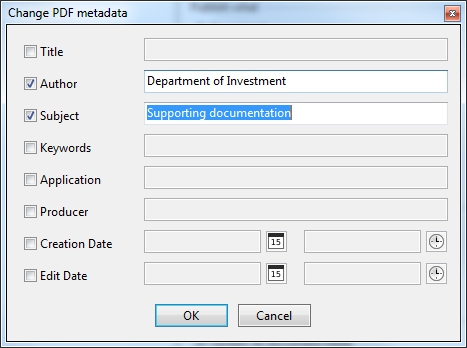
PDF Truck allows you to change all the basic metadata fields of a PDF document for the entire group of files selected for processing. When you select this option, the dialog will open. Only checked checkbox fields will be changed.
Any changes to the metadata will be reflected in the summary document if this option is used in conjunction with the Merge output documents to single PDF.
Encrypt PDF document
PDF files can be encrypted. When a password has been set, you will be prompted to enter the password before being able to open a file. In addition, permission restrictions may be added, such as the restricting of printing or copying text and illustrations. Selecting this option will open the PDF protection settings dialog.
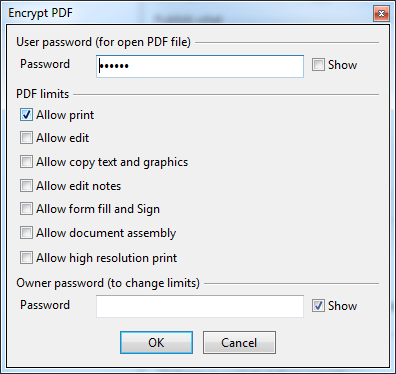
The user password is the password for opening the document. If you specify only this password, it will be requested when you try to open a document. Without entering the password, the document cannot be viewed. The second password is the owner’s password. It is needed to change the restrictions. If you do not set it, then the permission boxes can be disregarded.
If required, you can set only the owner’s password. In this case, the document can be opened for viewing without entering a password, but there will be restrictions, for example, on copying text.
PDF Truck uses AES 256bit encryption to protect documents. This means that if the user’s password is sufficiently complex, it will be almost impossible to guess. As for the owner’s password and action restrictions, these options are intended to protect the document from an unauthorized user and can be removed using specialized tools.
PDF encryption and restrictions are also reflected in the summary document if this option is used in conjunction with the Merge output documents to single PDF.
Include source file to PDF as attachment
This option allows you to attach the original document to the created PDF. Together with the
additional option to Zip / encrypt, this allows you to prepare PDF documents
with an attachment in the form of an archive, which is usually encrypted, which contains the
original documents.

PDF Truck has an embedded Zip archiver that is natively supported by most modern operating systems. In addition, if third-party archivers such as Rar or 7-zip, PDF Track will automatically detect them and offer to use them for compressing files.
The built-in Zip archiver uses Zip 2.0 encryption, which is considered obsolete. Therefore, if you intend to archive important files, we recommend using an external archiver.
Profiles
This section is intended for advanced users and system administrators.
Profiles are powerful tools for setting program parameters and for converting documents to PDF files. They allow you to select and set the settings for the visual components of all windows of the program and to customize the conversion parameters.
Profiles are files with the .ini extension. They must be kept in the profiles/
subdirectory of the program directory. At startup, if the set language is not English, the language
profile is always loaded first, for example, _ru_RU.ini.
Then the default pdftruck.ini profile is loaded.
All other profiles are set up using custom settings and can be loaded from the main program window.
As an example, let us create a profile by clicking the Save button:

After clicking the button, you will be prompted to specify a name for the profile. By default,
it is Profile1. Some of the content of the generated profile file is shown below.
; PDF Truck Config Profile
; Create at 2021-05-17 19:08:47
frmMain.pageControlPreferences.TabIndex=4
frmMain.rbWRangeAll.Checked=True
frmMain.seWRangeFrom.Value=0
frmMain.seWRangeTo.Value=0
frmMain.rbWPrintDoc.Checked=True
frmMain.cbWIncludeBookmarks.Checked=True
frmMain.rbWBookmarksByHeading.Checked=True
frmMain.cbWIncludeDocProps.Checked=True
frmMain.cbWIncludeDocStruct.Checked=True
frmMain.rbWOptimizeForPrint.Checked=True
frmMain.cbWUseISO19005.Checked=False
frmMain.cbWRasterizeFonts.Checked=True
frmMain.cbWUpdateFields.Checked=True
frmMain.cbWDeleteHyperlinks.Checked=False
frmMain.rbERangeAll.Checked=True
frmMain.seERangeFrom.Value=0
frmMain.seERangeTo.Value=0
frmMain.rbEPrintBook.Checked=True
frmMain.cbEIgnorePrintAreas.Checked=False
frmMain.cbEIncludeDocProps.Checked=True
frmMain.rbEOptimizeForPrint.Checked=True
frmMain.cbEDeleteHyperlinks.Checked=False
frmMain.rbVRangeAll.Checked=True
frmMain.seVRangeFrom.Value=0
frmMain.seVRangeTo.Value=0
frmMain.cbVColorAsBlack.Checked=False
frmMain.cbVIncludeBackground.Checked=True
frmMain.cbVIncludeDocProps.Checked=True
frmMain.cbVIncludeDocStruct.Checked=True
frmMain.cbVUseISO19006.Checked=False
frmMain.rbVOptimizeForPrint.Checked=TrueAs you can see, a profile is a set of property-value pairs. The property value consist of the name of the window (form), the name of the interface element (component), and the property. The dot is used as a separator. All properties related to document conversion are saved in a profile, but in addition, there are many other properties. For example, you can add the following line to your profile:
frmMain.rbWPrintWithMarkup.Enabled=FalseIn this case, the document option of conversion mode selection correction is inactivated.


